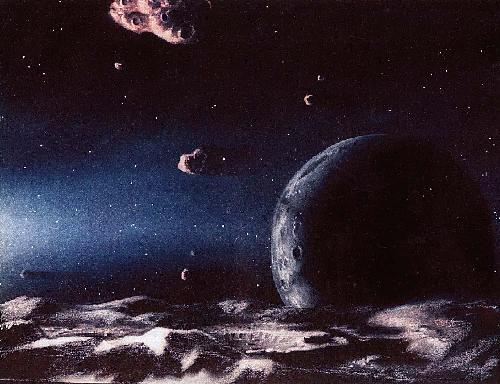 |
 |
|
| Comet | Jewitt | Kuiper |
|---|
| Ice As An Activity Driver |
|---|
Introduction
The data are compatible with main-belt comet (MBC) activity being produced by the sublimation of water ice. This is the same process that drives activity from the nuclei of "ordinary" (e.g. Kuiper belt) comets when inside the orbit of Jupiter (outside, other more volatile ices like carbon monoxide, CO, seem to control the mass loss).
Sublimation Rate
Dirty ice exposed to the full heat of the Sun at 3 AU sublimates at about
300 Angstroms per second, or 2.5 mm per day. In a year, a full meter of ice
would sublimate away and, in a few centuries, a sublimation-produced hole
hundreds of meters deep would be produced. We conclude that exposed ice
cannot survive for long on MBCs. If it is there, it must be recent.
Stability
Calculations by Norbert Schorghofer (which parallel ones done earlier by
Frasier Fanale and colleagues) show that a very modest layer of porous
dirt can effectively stifle sublimation on MBCs. Specifically, a meter-thick
porous dirt layer can protect buried ice for essentially indefinite periods.
It does this both by intercepting the Sun's heat before it reaches the ice
*and* by blocking thr flow of sublimated gas into interplanetary space.
Activity Trigger
If the ice is buried, then we need a "trigger" to expose it to the heat of the Sun and so to create the MBC phenomenon. What could that trigger be? There are at least two possibilities that may operate separately or together.
First, as in "normal" comets from the Kuiper belt and elsewhere, the rising temperature resulting from decreasing perihelion distance can trigger cometary activity. This is may be the trigger in P/2008 R1, an MBC in an eccentric, unstable orbit with a small perihelion distance.
Second, small impacts with asteroid belt boulders could puncture the porous dirt layer ("mantle") and expose buried ice. A meter-sized boulder impacting at 5 km/s (the typical velocity dispersion amongst the asteroids) would be enough to blast a hole in the mantle big enough (a few 10's of meters) to supply sublimated matter to the coma at the rates observed. Impacts are a plausble trigger for MBCs having stable orbits, like prototype 133P.
The abundance of meter-sized boulders in the asteroid belt is not observationally accessible (a 1 meter boulder at 3 AU from the Sun would have magnitude 37). But an extrapolation from larger sizes suggests that impacts might be sufficiently frequent to act as triggers.
Contact David Jewitt [djewitt@gmail.com 808-956-7682]
David Jewitt. Last updated Feb 2009
 |
 |
|
| Comet | Jewitt | Kuiper |
|---|